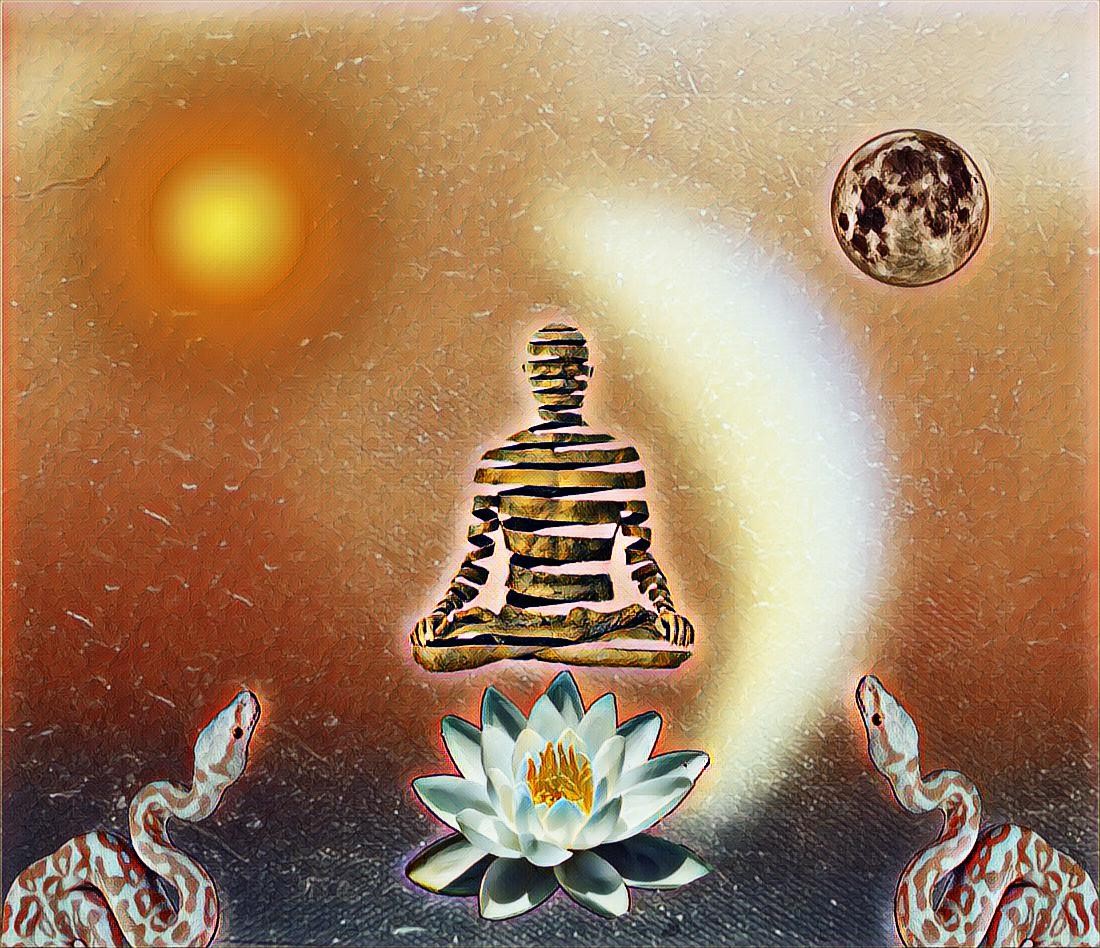- Visitor:37
- Published on:
Self and Self-Becoming in Individual and World: The Fourth Brahmana from first Adhyaya of Brihadaranyaka Upanishad (Part 2)
Right in the beginning, there was Atman alone in the shape of a person. It looked around and saw nothing other than itself. This act of ‘looked around and saw’ or this looking around is the chakravartin. This is the solar traversal. It is measuring itself by a certain outlook.
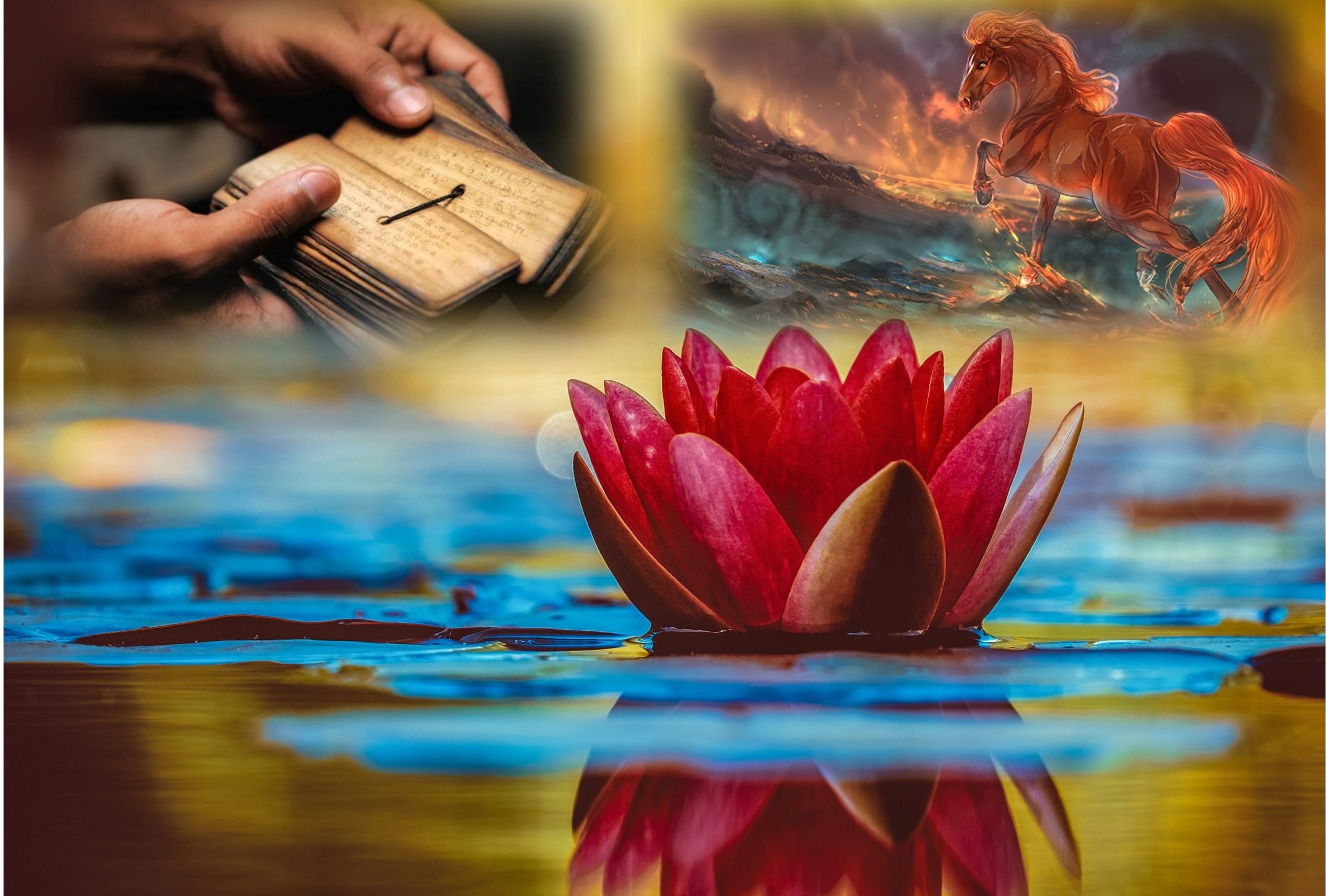
The following content is edited by Rajabhishek Dey (Centre for Indic Studies) from an online talk and question-answer session on Part 1 of 4 in a Workshop by Professor Debashish Banerji at Sri Aurobindo Sadhana Peetham Lodi, CA September 17th, 2022. The original speech is reshaped in this article format with an intention to spread his voice more for our readers. The discussion is taken from the YouTube channel of Sir.
"This workshop continues the consideration of the first chapter (Adhyaya) of the Brihadaranyaka Upanishad. The first in the series dealt with the cosmic Time-Image of the sacrificial Horse (Brahmana One) and ontogenesis of Time from the "eternal event" of its Sacrifice (Brahmana Two). The second in the series (Brahmana Three) considered a cosmological approach to the same ontogenesis, now seen as a trans-individuation of the gods in their negentropic re-membrance aided by the psychic "breath in the mouth." This third workshop in the series deals with the next section (Brahmana Four) of the first Chapter, which takes a phenomenological approach to the same ontogenesis, now seen in terms of the self-evidence of the Self (atman) and the Being (Brahman). It introduces several "mahavakyas" (great sayings of the Upanishads) pertaining the spontaneous knowledge-by-identity."
… continued from last part
Q. You were expressing infinity as a point of view. Also, you are using words to express the infinity from which you could look at the finite. Now, if we consider the way that you are talking and said, “this is the way that the seers see”, then can we see the finite from there in its relation to that?
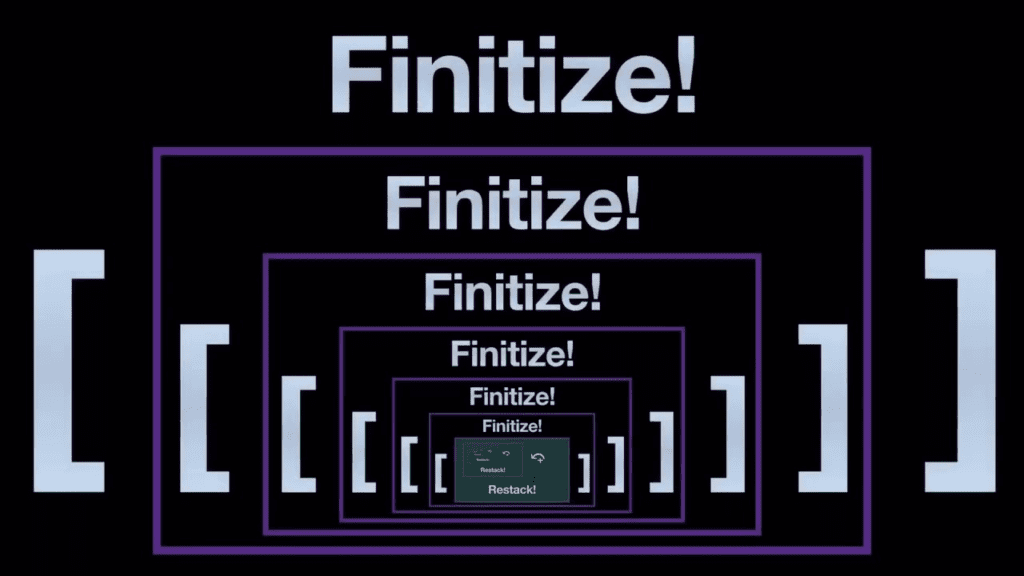
A. Absolutely. Our normal experience is the sacrificed experience. The sacrificed experience is an experience of finitude. It is also of temporality which is its own kind of finitude. Experiences of time are finite experiences starting from the fact that we are born and then die. We move through the cycles of days and nights. We experience things as events that have beginnings and ends. These are all finitude of experience. Similarly, our spatial realities are also finite. The way we perceive things is finite. Hence, you’re absolutely right! This is a way by which there is an infinite perception that has ‘finitized’ itself. Furthermore, part of that we will study here and see the ‘happening’ talked in a secret manner about how infinite speed is (in relation with infinity) and the finite is in relation with infinity. To be finite is to live in a world of relations. It is to say that the radically infinite is absolute. The absolute has entered into a world of relations, into a relative world. How does it do that? It does that through the power of consciousness. These are all appearances that it sets up. We are experiencing that appearance. That appearance has the ‘sacrifice’ at its origin. The sacrifice is the loss that makes it possible for it to gradually remember. The term “gradual” brings infinitude.
Q. You were talking about when you move from ontology to cosmology and said that the gods were no longer outside, but inside, in our senses. They are faculties. Could you say that seeing (not the seer) and hearing is one of God’s actions that’s inside of us (when you get Sri Aurobindo’s science on divine hearing and seeing) and He’s expressing that?

A. Absolutely. This equation is going on in the very first Brahmana as well. When I’m talking about the ontology of the horse they are already preparing for the third Brahmana. Because they are saying that here is the horse and its head is the dawn Goddess Usha, its eyes are the sun god Surya (Aditya, the son of Aditi), it’s breath is the wind god by Vayu and from its mouth emerges the god of fire Agni. These Vedic gods are already mapped to the faculties of the horse and these faculties are then mapped in the third Brahmana to the psychological properties of all of us.
Q. What is the relation between infinity and the void?
A. The condition of the sacrifice is really an absenting of consciousness. It is consciousness that has by its own power absented itself, become unavailable, creating space as void. Existence or pure being without consciousness is death. That’s the sacrifice of the horse- the cosmic horse has absented its power of consciousness and therefore it is also infinite. But it is death that is infinite and it is infinity as death. It is the infinity of death.
Q. Can we say that this void is kind of proof of the radical feature of the infinite as Sri Aurobindo says that it is something that which includes its opposite?

A. Exactly. The void is often considered to be a door to the other (the ‘tat’) and the other has to pass through this portal of the void of that which cannot be known. These are the three categories of the Upanishads of knowledge. They are the epistemology of the Upanishad –
➥the known,
➥the unknown and
➥the unknowable.
Between the unknown and the unknowable stands the void. It is the gateway to the radical infinity that can always be something ever, other (wholly other) than whatever we can even know. That is the purnam and if you take the purnam from it the purnam remains. The door to that is the void.
Q. Can we say that these known, unknown and unknowable are an evolution of Brahman into psychology? What is the trajectory?

A. No. As far as that is concerned, I’m saying that the ontology to the cosmology and then, to the phenomenology is really from the external ⇒ to the internal. The reason is that it is not an evolution. They are providing real ‘perceptual frames’. They are giving you those frames because firstly we are experiencing outward and then inward. They are trying to take the Vedic understanding of reality and saying, “All these things that you’ve heard, they actually translate to something inside you”. It is a contemplative philosophy. It is contemplated because it asks you to bring it inside yourself and experience it from within. So, this Brahmana that we are considering today, is in that sense, the most esoteric and makes us dive deep into the contemplative reality of the ontological and the cosmological.
Q. Please discuss the context of Brihadaranyaka Upanishad.
A. I would like to put it very briefly, because my understanding of it is not the traditional understanding of it. The traditional understanding of it is that the Brahmanas are early Vedic texts. In fact, when we use the term ‘Veda’ or ‘Vedic literature’ they mean not only the four Vedas but they include the Brahmanas and the Upanishads. The whole corpus is called Veda. But, if we really study it, we see that there is a historicity to the whole thing. It is not that these came down all at once as a single body that we can call the Veda. There are various layers to it and the Brahmanas are already a ritualistic interpretation of the early Vedas. Ultimately it’s only the Rig Veda that is original. Then, the Atharva Veda has a large number of original hymns including some of the hymns of the Rigveda. The other two Vedas are mostly just repetitions of the Rig Veda. Additionally, the Brahmanas are putting a ritualistic spin. It has legends, it has rituals and it has ways of using the Vedas to do various rituals. It is presenting a social world that is determined through ritual. That is the Vedic world. The Vedic word is a world in which to be born you need a ritual, to become a king you need a ritual, to have a home you need a ritual and to die you need a ritual.
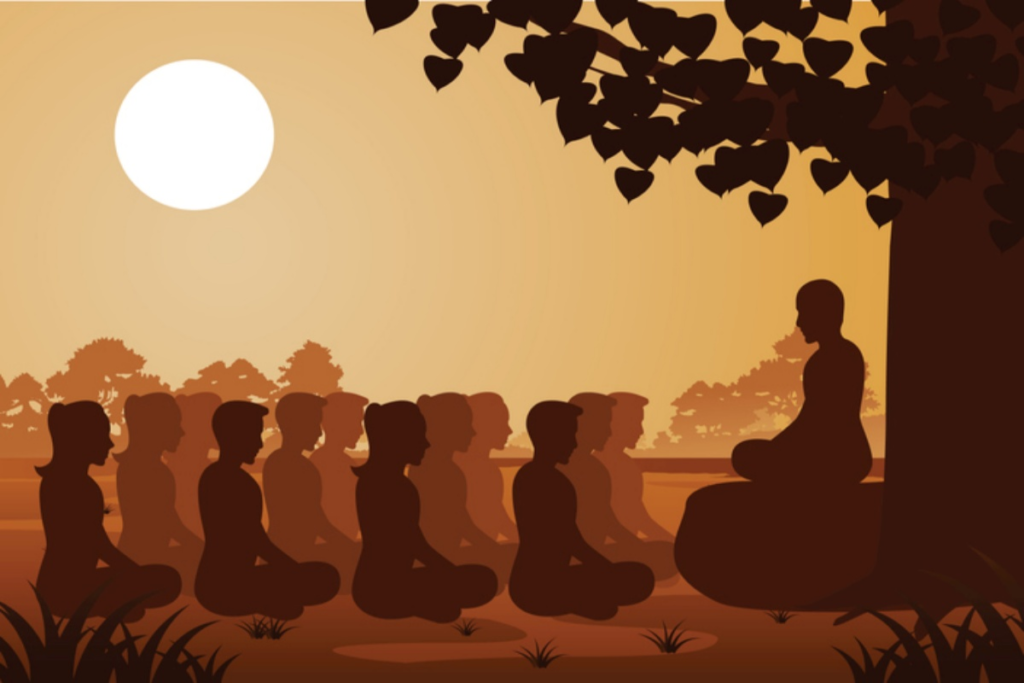
Hinduism is made up of all these things even today, except that the forms have changed. But, these were what that completely determined the society at that time, including the four castes. The Brahmanas are the texts that are solidifying all that, turning the Vedas into ritual texts. Then, there is the interesting conflation when we are talking about Aranyakas. The last part of the Shatapatha Brahmana is the Brihad Aranyaka or the great Forest texts.

These texts, called the Aranyakas are being written by people who are going out into the wilderness and are giving us esoteric texts that are to be contemplated. Further, they’re saying, “It is not about rituals. It is about the experience”. The Brahmanas have nothing to do with the Aranyakas or Upanishads (as far as I understand it). But due to historical politics, at a certain point in time people came and added them to the Brahmanas and said, “These are the Brahmanas”. The Brihad Aranyaka Upanishad is a part of the Brihad Aranyaka. There is a larger envelope- the Aranyaka and then the Upanishad and inside the Upanishad, there are three books called kandas. Here, we are studying the first book which has two chapters (Adhyaya 1 and 2) and then the second book or kanda has two chapters and again, the third book or kanda has two chapters also (in this study, we are looking at the first section of the first chapter of the first set of two and focusing on the fourth section within that chapter). If we look at these, we find that they’re also not written at the same time. In addition, they are not single texts. They are also written separately and pulled together, compiled and edited.
Q. It seems like that in the Vedic civilization around that time, the idea was to experience. And, over a period of time people have tried to keep bringing that idea back to the experience. So when you’re experiencing, for example anantam, then in the difference between anantam and infinity, anantam would be more like unending, experientially that is different than infinite and not finite. So, you’re experiencing something that it is ‘not’ versus ‘something that keeps unending’. For example, we can consider the bliss that comes from the experience of anantam versus infinity. So the question is how in experience anatam different from ananta?

A. Anantam does not mean unending. Ananta and anantam are two different things. Anantam is the category of the infinite. It is not that which does not end and which is within time. If you say it does not end we are already placing it inside time. Anantam is an objective correlate of ananta. When we say antam we are making it into our neutral noun form. We are talking about it as a thing. It is an objective thing or infinity, not the infinite progression which is ananta. In experience, one is still unchanging and the other is changing all the time. One is eternal, while the other is perennial. Ultimately Bliss is the same but it is translated into experiences in time and the other one is the experience all at once. That is the difference. In other words, the experience in time has varieties of bliss to it. Here, qualitative changes of bliss are taking place and it expresses infinite quality that we call “ananta guna”. However, in anantam, it expresses no quality. It is blissful but it is nirguna- nirguna ananda. While the other one is the ananta guna ananda– the ananda of infinite qualities, depending on what is expressing at that time.
Now, we move on to the beginning of the Brahmana 4. The translation is as follows:
“In the beginning, this universe was Atman alone (self) in the shape of person or purusha (In this translation a little bit of change is made because if one really looks at those Sanskrit terms there’s no word for Universe there). It looked around and saw nothing other than itself. This is the crux of this looking around. He first said, “Soham Asmi/ I am He”.
Therefore arose the name “I” or “Aham”. Hence, even now when a person is addressed he first says, “It is I” and then says whatever other name he may have. Because it burnt (the term used is aushat) and all evils(papa) before it, therefore, it is called purusha (pura + aushat). Pura means to be in front and puraaushat means burnt in front and hence the term purusha.
“Who knows this verily burns up him who or what wishes to be ahead of him”.
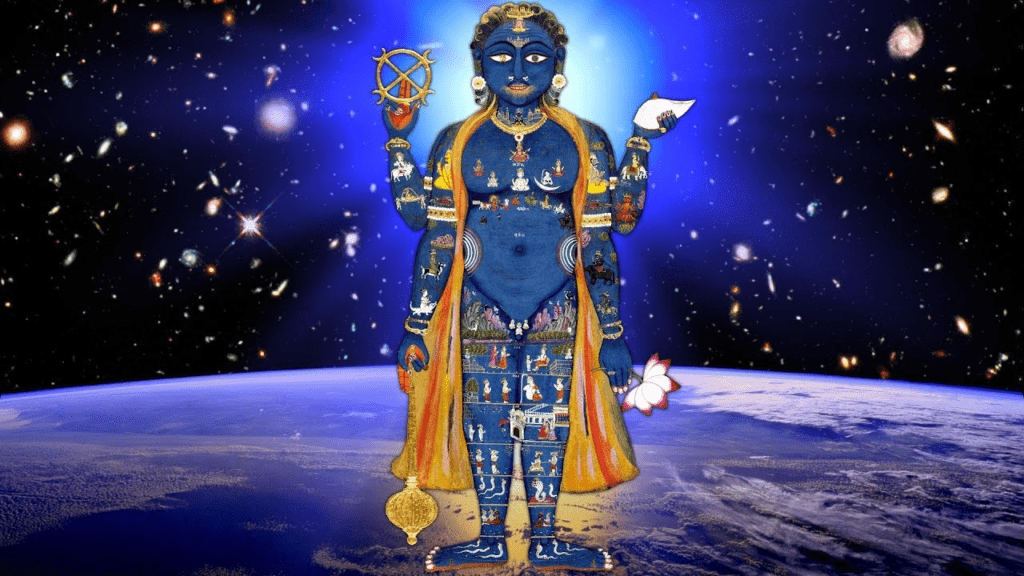
Now, let us go through the commentary of this. We are made aware (at the inception of the Brahmana) of the equivalence of the horse with the person (purusha). It introduces the two terms into Upanishadic texts –atman and purusha. Purusha is already there. It has come to us from the Veda. But, it has introduced atman. It is talking about the horse in the first two. In a sense, it is now telling us that the purusa’s sacrifice is the sacrifice of the horse. It is showing us the equivalence of the horse with the purusha. The sacrifice of the horse is nothing other than the sacrifice of the purusa in the Rig Veda. The purusa is the person, the experiencer (this is where the register is changing from the cosmological to the psychological and notice, you are the experience). The essence of the experiencer is self-consciousness. This is Atman- the consciousness of self, that which we take to be ourselves. Self-consciousness is self-evident. There is nothing that can describe it. We just know it by its self-evidence. It is subject without object. You do not need anything to know that you exist. Its mode of knowledge is known as gnana.
This is again I was talking about the second term gnana from the Taittariya Upanishad. Consciousness/ chit/ atma-chetana/self-consciousness is that which knows itself as knowledge.
↬How do we know that we exist?
↦We know ourselves to be existent without any external evidence. We don’t need senses to know that we exist.
↬What is that form of knowledge?
↦That form of knowledge in the Upanishads is called gnana.
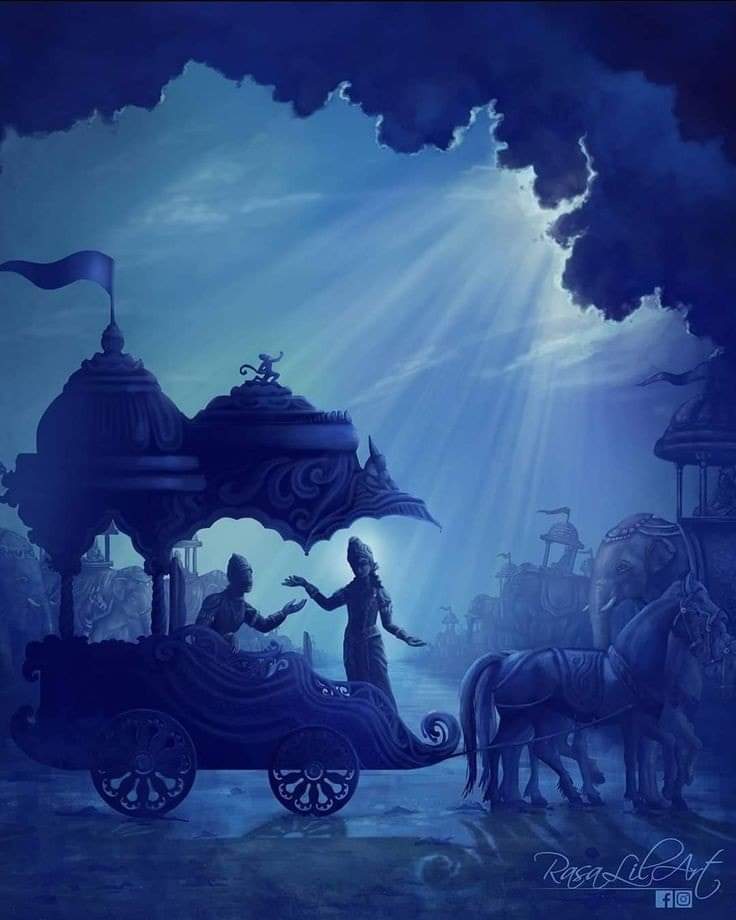
This also translates to the Gita, in the famous chapter 7, which is called gnana-vigyana yoga. The yoga of gnana and vigyanam are two terms of the Upanishads that are central to epistemology, the theory of knowledge. Moreover, they are also central to Sri Aurobindo’s epistemology. Gnana is essential and self-evident knowledge. It is the knowledge that needs no instruments, knowledge without object, knowledge of the subject, knowledge of the atman (atman as knowledge). Its mode of knowledge is known as gnana but the subject can also objectify itself and specialize itself by stating, “I can look at myself and I can mobilize my consciousness. If I don’t mobilize my consciousness, I’m just knowledgeable of myself without any object (ghana). But if I try to bring my attention to myself I’m reflexive in my attention. I begin knowing myself in a new way- a way that is specialized and objective. It can objectify itself and specialize itself. This is vignana”. This is how the Gita describes it.

This term is at the center of Sri Aurobindo’s entire teaching. Vignana is supermind according to him, at the ontological level. It is that by which reality knows itself in its parts. As per its description, it is like the horse’s self-knowledge of itself as the horse. Not only from within it knows itself as the self of horse but it also knows itself as ‘horse’, with its relations, its parts as an object. Every object is nothing but the subject and the word of relations that it creates is nothing but the subject as an object. This is vignana. Self-consciousness is then the consciousness of experience between subject and object, where both of which are ‘self as subject’ and ‘self as object’. This is a person or experiencer experiencing itself with the essence of sense. This is an operation of pure knowledge that reverses itself at infinite speed. Here we can say, “I know myself essentially but I also turned myself on myself to know myself”. So, I am utilizing a sense or the essence of sense. Further, this self-knowledge as an object, looking at ‘myself as an object’, is as primordial as my knowledge of ‘myself’ without an object. This is just subject knowledge. It takes place and is known at once and at the same time. Consciousness knows ‘being’ both intrinsically as ‘being’ and in its infinite possibilities as an object of being. This is its cosmic possibility. That is why at the head of time, head of space and the cosmos stands the supermind or vignana.
In other words, it traverses an infinite distance at once.

Now, we go back to that notion of looking around. It looked around and saw that everything is “I”. However, it didn’t need to look around. Why did it look around? That is the hapless question of all of us, the unhappy people. However, one can say that it was lonely. That’s another very profound idea because it can never be lonely. It is everything all at once. But once it knows itself as ‘two’ it cannot go back to being ‘one’, although it still is one. Yes, it is one and two at the same time. Now, what if it looks around to know where it is in terms of location? We can say that it is a centerless circle. It is not only a circle without circumference but also it is a circle without a center. We are all its centers. Every infinity to every particle in that Infinity is a center of the circumference-less circle. That is why it is decentered. This is where its social manifestation is something that is displacing the idea of the Veda. It is refusing the chakravartin and saying every one of you is the chakravartin.
So it traverses an infinite distance at once and thus the self-object objectification of atman as purusha or experiencer produces itself as infinite space, in an act of experience or knowledge. In the sacrifice of purusha it is the self-consciousness of purusha, its gnana of Atman which is obscure. This is what happened in the sacrifice of purusha. We were talking about the void in which self-consciousness is obscured or consciousness of self is obscure. Here, the self is there but its consciousness is obscure. Moreover, consciousness is absented. In its re-emergence, it is its power of objective experience or vignana that acts and gives evidence of its essence as gnana of atman.

Here, what this literally means is that in the origin at the point of the sacrifice, there is no ‘I’. There is an ‘am’. In a flash there is the ‘I am’. As a consequence of that ‘I am’, you realize the ‘I’. Consciousness is absented and obscured and there is a sense of being a self that does not know that it is self. Suddenly it awakens and knows itself as that ‘alone’ which is. In that knowledge, it knows that it is a ‘self’ and it is an ‘I’. After the sacrifice, it is vignana that allows us to know gnana. This is the inversion that has taken place. Before the sacrifice, there is only gnana. After the sacrifice, it is vignana that allows us to know what is gnana.
Q. In this process what is the need of manifestation of relativity or relative experiences as ‘I’? As each of us is chakravartin, that is why creating infinite within the infinite, many infinite or relativeness. But, what is the need? or what it essentially means here?
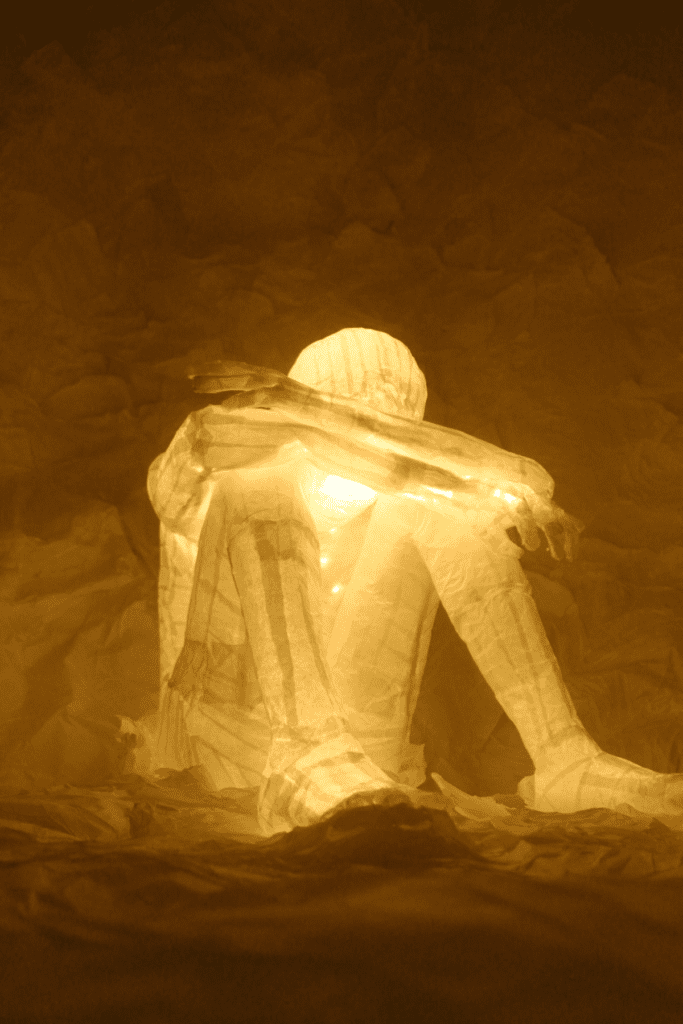
A. This is because it’s like saying that it is the awakening of the full cosmic sense with all its relations that come to light in the self-knowledge. That coming to light in self-knowledge is inextricable totality (the whole with all its relations that comes to light). That comes to light in each of its relations. If it comes to light in you, it doesn’t only come to light as you. It comes to light as the cosmos with everybody else in it and all their relations. It is like knowing in itself everything else that is in it. In other words, we can say that in this “everything else in it”- knowing in itself is everything else in it. This is the infinity that is known as vignana.
Q. What is the need for that vignana?
A. The need for that vignana is that there is no need for it. It exists. It is like saying that (if you could say that there is a need for it because the idea behind this is ‘whatever is possible is’) if there is an infinite being that is conscious it must activate its consciousness. This is because that’s a possibility of consciousness. You can have a world in which it does not activate its consciousness. That is also part of its vignana.

In its re-emergence, it is its power of objective experience (vignana) that acts and gives evidence of its essence as gnana of atman. The operation of vignana is the traversal of distance and the recognition of itself everywhere. This entire thing about how it begins is like a big bang. It is really the big bang. Right in the beginning, there was Atman alone in the shape of a person. It looked around and saw nothing other than itself. This act of ‘looked around and saw’ or this looking around is the chakravartin. This is the solar traversal. It is measuring itself by a certain outlook.
Q. If it is just infinite in itself, how can it look around?
A. That’s the thing. It can look around because it is also conscious. It mobilizes its consciousness. Furthermore, its ‘looking around’ is done at infinite speed. It sees itself at once. This is self-knowledge. It is not its essential self-knowledge but its objective self-knowledge.

In Kashmir Shaivism they talk about two forms of the same two forms of gnana and vignana. They call it prakasha and vimarsha. Prakasha is Shiva’s knowledge of himself without any particular objectification. Vimarsha is Shakti’s knowledge of Shiva, the self-consciousness that turns upon ‘being’ to know itself. What does it know? What does it see? Without objectifying itself it doesn’t know what it is. It knows it exists. In the Ardhanarishwara image, we find the female part is turning a darpan or mirror on itself. What is that mirror? That is looking around and seeing itself. As it sees itself it sees Infinity. It sees every possibility now and forever, their relations and their possibilities of relation.

This impossible image is what the Gita is talking about as the ‘Vishwarupa’ that which Krishna bestows on Arjuna. Thus, it is an ultimately paradoxical image. That is why this question is raised. How can it see itself? It is an ultimate paradox. It sees itself and its Infinity all at once. That is the condition of supramental consciousness. It is worth contemplating because it gives us a taste of what we are trying to aim for in the “Integral yoga”.
Q. Then, what about self-awareness?

A. Self-awareness is already there. It is not self-awareness. It is much more than this. Sri Ramakrishna, who actually uses vignana in the same way as Sri Aurobindo does and is one of the first to use vignana in this way says, “Vignana is much greater than gnana”.
Q. Scientifically it basically virtualizes the light that where it is coming from. So could that virtualization as creativity be also part of the image of the mirror?
A. Yes. Because that’s exactly what are the possibilities that it contains with creativity. It is the virtual space of what exists. “What exists?”– it is again this whole question about what we see in front of ourselves. Including the finite and the infinite, what we see in front of ourselves is already a projection. But if that which we see is seen in its totality, it would be very different from what we see. It would be the Vishwarupa. That’s what the mirror shows.
Q. In looking around and then that connecting to the turning of the wheel, the solar ritual and the procession of the sacrificial course that’s all energy, motion and movement. So how does that connect to the experience of looking around?

A. If we translate it to the idea of the horse and its movement in the ‘geos’ or in the social sphere that is an approximate translation that actually the Upanishads are trying to distance themselves from. They’re talking more about you know like images of the day like ‘how do they give these images of the sun coming up’. It isn’t talking about the notion of a little bit of the earth getting illumined. It gets illumined all at once. It is like not the light of the moon or the light of a fire but it is the light that just turns on and everything is illuminated all at once. This is the looking around of vignanam. It is not they are looking around at the horse that takes its year. This is the relativity of time- what is the year to the horse and again coming back to the infinite and the finite. Further, it is a slowing down of that which occurs all at once. That slowing down in a particular Brahmana includes every one of the creatures of that particular manifestation. In that sight of vigyana is a self-knowledge that experiences that infinite velocity at a relative velocity. Moreover, this relative velocity depends on the quantum of consciousness in each of them. The days and nights of an ant are durationally different from the days and nights of a tree or the days and nights of a human or the days and nights of the Gods. But, they’re all relative due to the slowing down of infinite velocity in looking around.
Q. Can you explain the “circle” because when there is no center of the circle? We cannot imagine any circle without a center. So, how can I imagine this point?

A. If you experience something which starts from you, the idea of a centered circle exists because each one of us experiences reality in a centric way. It’s an egocentric view. That’s why our realities are always centered in ourselves and everything else rotates around us. But if you were to realize all of everything at once, you’d realize that there is every particle, that is possible, has its own center. So experiencing that along with the fact that all that is one. This is a paradox including all that we are talking about, everything that I’m talking about.

Which is why you are raising the “how” question. It is starting from the finite and the infinite asking ‘how’ can it look around? ‘how’ can there be infinite centers? Each one of these is a paradox. The very fact that the question has arisen means that you have to contemplate that paradox as an impossibility to our consciousness but a possibility to supermind. Additionally, in contemplating that we build aspiration and building this is the whole aim of the Upanishads. If you did not have that aspiration for the impossible there would be no supermind for you.
Q. The infinite centers exist but at the same time when you see everything together, it doesn’t exist. Is there a relation of quantum mechanics with this where the existence and non-existence is considered simultaneously?
A. Quantum mechanics has risen due to the confrontation with a microcosmic and an astrophysical reality that is paradoxical. It has built mathematical models to talk about that paradox. This is why there are so many interpretations of that. But we don’t know what it is. So that’s exactly where science has today entered the borderlands of the mysterious and paradoxical. It raises the same question “what is this?”. It is outside of our rational frame but it is a reality that opens an aspiration to experience another mode of consciousness that we don’t have right now.

We are still talking about the looking around of Atman and I was pointing to that as the operation of vignana, as a self-objectification and perception of all the possibilities of self (the extension of self). The operation of vignana is the traversal of distance and the recognition of itself everywhere. It is also the intuition of the duality of subject and object. This is the other aspect where it recognizes itself as subject and object which is the essence of duality. Hence, the starting verse of the Brahmana begins with the operation of vignana looking around and finding the self everywhere. The ‘looking around’ is the act of self-reversal. It is the movement of consciousness (chit) in being ‘sat’. That is sat-chit-ananda where anandameyee, chaitanyamayee-satyamayee paramayee or Supreme is ‘being’, ‘consciousness’ and ‘delight/bliss’. Consciousness activated in being, consciousness looking around to see being, arising from the sacrifice of purusha and the obscuration of self-consciousness (atman)- it is of the nature of sudden enlightenment, repossessing the consciousness of its extent as an infinite oneness in the instantaneous act of looking around. The way the Upanishad is presenting this is not as a gradual self-recognition. It is first in the nature of a sudden self-recognition. The gradual self-recognition follows the sudden self-recognition. Something suddenly wakes up and there’s a surprise to it. Then, it starts waking up in a gradual manner. The operation of vignana is instantaneous reflexivity, in which at once the person (purusha) recognizes itself as experiencer recognizes the extent of itself in experience and recognizes its essence as self-illuminating (self atman) and source of self-evident knowledge gnana. All these things comes to know at once. From its absence there was nothing and suddenly there is everything. This is like the sun awakening in the darkness. It is a binary process. There is zero and there is one. That is the duality of it. There are two kinds of epistemologies- the epistemology of duality and the epistemology of unity. The epistemology of unity under conditions of duality is a gradation. You either have one- which is only one, where there is no differentiation or you have two, which is a sudden duality. In the sudden duality, the one recognizes itself as a gradation.

Extent implies measure and objective knowledge implies duality and purusha is atman inhabiting an infinite word of measure, in a mode of duality through the operation of reflexive knowledge (vignana).
(Here, extent implies the measure up to which it sees itself everywhere. What is this everywhere? We talked about this notion of suddenly that which had no extent and now has an extent. It is that which was spaceless and now is space, we call it infinite space. It is the sense of space. The sense of space also opens up the measure of space. This is the gradation.)

The first verse recognizes these elements in saying that in the beginning there was nothing but atman who wore the form of purusha. Atman, as purusha looks around and sees none other than himself everywhere. With this, it also awakes to its essence as self. Thus, its first action of self-experience is to affirm its self-existence throughout its extent, measured by its reflexive self-consciousness. One of the great sayings or ‘Mahavakya’ of the Upanishads is used to make this affirmation. This is the first time this particular statement is being made- Sohham Asmi. This statement ‘Soham’ is going to become one of the Mahavakyas or great sayings of the Upanishads. In other words, this is one of its contemplative seeds regarding how the Upanishad operates as a contemplative text. This is one of the ways in which it operates. You can encapsulate its meaning through a few contemplative scenes. So, all that it’s saying becomes encapsulated by that one sentence ‘Sohham Asmi’ or ‘I am that’. That is what the self says in its self-knowledge of itself everywhere. It looks around sees itself everywhere and says, “I am that. I am He. I am the One”. That becomes a contemplative seed for everything inside that creation as well. This is why the repetition of the Mantra (it is a mantra- Sohham) to this day many many schools of yoga practice this. Mantra repetition and concentration on this mantra- “I am that”.

Now the interesting thing is that in this phrase “Sohham” or “Soh Hamsa Aham”, “Soh” means “he” or “it” and “aham” means I. So, “Soh Hamsa Aham” means, “He am I” or “I am that” or “I am it” or “that which is”. This term repeated becomes the sound of the term “Hamsa”. Ahamsa- Ahamsa-Hamsa. In Vedic grammar there’s a Vedic Construction in which you take two things, put them together and clip off the first word and the last word on the sound-the first syllable and the last syllable. Like, “Aho” meaning day and “Ratri” meaning night can be put together and then take out the “A” and the “Ri”. So you get “Hora”. Hora means the duality of day and night. Similarly, in Ahamsa, when you put together, take out the “Ah” and you get Hamsa. Again, hamsa is the swan. This is the Divine swan. In the Vedas, a number of references to the divine swan are there. Also, Sri Aurobindo uses it in one of his poems- “Swan of the supreme and spaceless ether wandering winged through the universe, spirit immortal.” That’s the looking around- “Hamsa. I am that”.
Its two wings are I and that.

It makes this affirmation “Sohham Asmi, I am that”. This is the assertion of an identity, mediating a duality, that of subject and object necessary to the self-experience of self (Atman), as person or experience of purusha. This distinction is going to be made throughout the Upanishads- person and self. In some Upanishads, the self will be preceding the person like in this particular case they’re together. Besides, in some Upanishads, purusha proceeds and it supersedes the self. The person is the experience and the self is its essence. Without the ‘person’, the act of looking around doesn’t take place. The ‘person’ is that in which the self and its consciousness are one. Sat and chit both exist in a person. This is why purusha is integral in itself. When we talk about integrality the first root of integrality is the oneness of self and consciousness, being and consciousness at once or quality and essence. Purusha is that in which this qualitative act of consciousness takes place from the self. The self becomes an object of itself. This affirmation marks the phenomenology of purusha’s spatial self-extension. In other words, those that exist within the cosmos made possible by purusha’s self-regard know themselves first and primordially by the self-evidence of this affirmation, which is the recognition of the atman existing as purusha or atman’s gnana extending itself as purusha’s vignana. This act becomes the basis of the self-evidence of our self-knowledge. If we ask that question how do you know that you exist? We come back to that. The self-evident sense of existence, that each of us has needs no description. It is because of the extension of its self-knowledge by primordial purusa. The cosmos that comes into existence is seeded by Sohham Asmi of self-evident self-knowledge. Everything in it has that sense of being, the self.
(Note: ‘It exists’ itself implicates to stand out. Existence itself implies looking around. And this looking around produces existence and here we are making the distinction between being and existence. ‘Being’ does not need to come out, being is there. By existence, it means what is experienced, what has come out. Now, sometimes the ‘sat’ is referred to as existence. In this kind of definition ‘sat’ would be ‘being’ while the cosmos would be existence along with satyam or truth. Truth is being, as super conscious being- the being that is the foundation of any possible cosmos, the purnam, the original purnam. That is satyam or truth.)

The Upanishad draws attention to this existential phenomenology by pointing to the original self-recognition of purusha, as cause for the primordial self-evident identity of all beings. Our self-evident experience of self arises due to that. That’s why the Upanishad will say, “Hence even now when a person is addressed he first says it is I and then says whatever other name he may have- that is it”. “This is I” is to say gnana of ourselves, the self-evident knowledge that cannot be described. I can only say I exist. I cannot say why I exist, how do I exist? What am I that exists? As soon as I say those things those are my other names. Here, I am describing myself to you or to myself, I am turning the mirror on myself and/or I’m using the essence of sense to make sense of myself. That is the vignana of gnana-vignana operating at the limited finite level. Think of that same vignana operating at the infinite level. That is turning the mirror on itself of ‘sat’. That mirror is ‘chit’.

The verse follows this assertion with a creative etymology of the word purusa, indicating the primordiality and primacy of its self-knowledge. What is the nature of this self-knowledge? That’s the connection. Why the abrupt shift is there to this line about the etymology of purusha? It is occurring because the intuitive link is in the nature of that self-knowledge. What is the nature of that self-knowledge? It is a primordial and primal self-knowledge. This primordiality and primacy of its self-knowledge is replicable in all beings. That’s why we can repeat the Sohham mantra and experience the original experience which is going on inside us- the “Sohham Asmi”- that being said. In ‘looking around’ is what constitutes the essence of our being. In repeating that we are repeating what it said to recognize its presence everywhere as cosmos and all it speaks.
The primordial nature of that Sohham is what is been pointed out in the next sentence, which is just like Sohham Asmi is replicable in all beings. “With the result of freedom from ‘papa’ or sin/evil and absolute power over all obscuration or impersonation…”.
Anything else that impersonates as ‘you’, that is what is meant by what comes ahead of you. “He”, “whom” that which comes ahead of you is that which impersonates as ‘you’, that which is taking your place. It takes your place so it comes ahead of you. It obscures your truth. But that utterance which knew itself everywhere immediately flashes forth and burns it up. It burns it up because ahead of or before all that there is the burning of all evil/papa and it is purusha.
“He who knows this burns him that which wishes to become ahead or before it”. This ‘ahead or before it’ has to do with impersonation and obscuration. Most primarily it’s talking about our own ego. It’s not talking about somebody else. That is the papa. That is the self obscuration. That stands in front and obscures the gnana of atman. This is the etymology of purusha. Also, this is the beauty of the Upanishads. Throughout it puns with all kinds of varied puns. Language games are used to force our attention on the beauty and depth of sound. Because this is again pointing to what is the essence of mantra. The mantra is not that which is repeated unthinkingly. Mantra is that which is understood in its deep essence as consciousness. The consciousness of the term purusa is being heightened. By contemplating the mantra Sohham Asmi we come to the experience of the Sohham Asmi . But contemplating the etymology of purusa, we understand purusha inside ourselves. Purusha is that which burns up all the obscuring agents in front of it.
Q. This Mantra that you’re talking about it has that word and sound element in it like the self looking at the mirror and seeing himself and there is something that lies between ‘He’ and His image, something not quite into any of this but is it something else?

A. That is the vignana. It is one and two at the same time. There is the third and that’s what will be explored further on. Throughout that third actually, we find the very essence of Upanishad. Upanishad literally means to sit close. To sit close is a duality which is unity at the same time. How close is close? Close at one limit is no distance. However, close to another limit is an infinite distance. This is the whole thing about the measure, the finite and the infinite- the two and the one, at the same time. It is a paradox. That’s why it
- 18 min read
- 0
- 0







